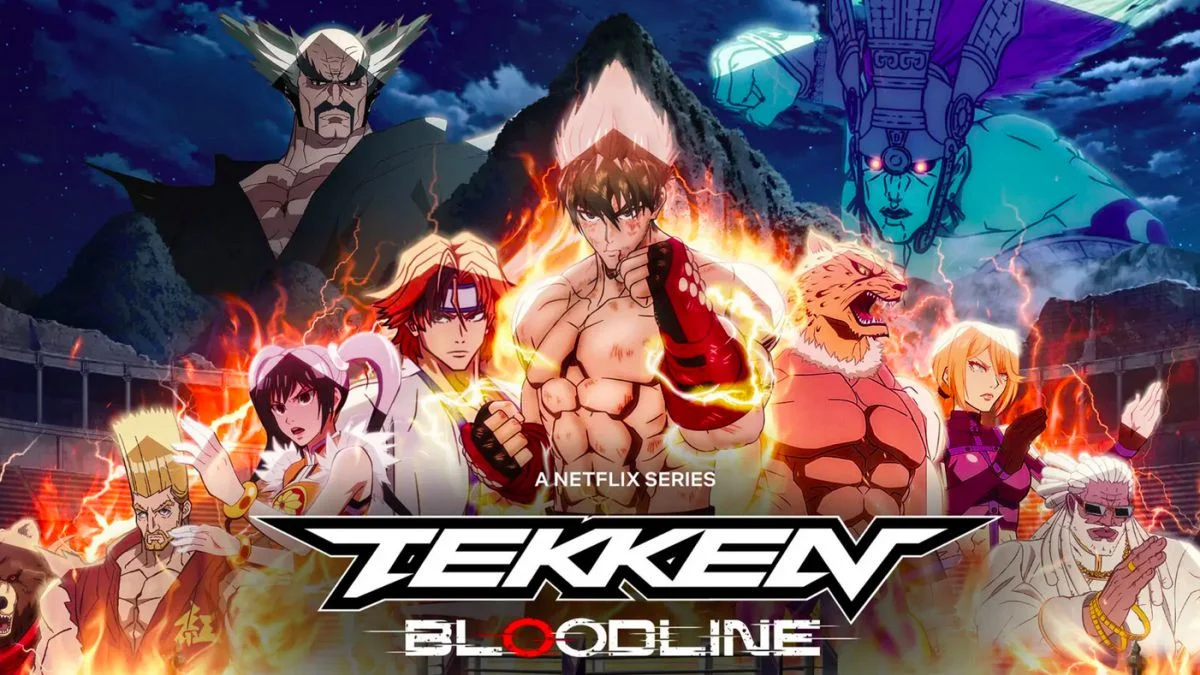It’s been about 11 years since the last debut of any tekken visual media, the movie “Tekken: Blood Vengeance” came out in 2011, which is 14 years out from 1997’s Tekken OVA Movie.
 “Whose Eyes peer back from the Darkness?”
“Whose Eyes peer back from the Darkness?”
In years past, story and context thereof have never really been things that Namco (now Bandai-Namco) have ever really properly elaborated upon in their critically acclaimed fighting game series, Tekken. It’s always been a thing that the gigantic community of fans have pieced together, while gleaning information from bios in game manuals, and ending movies after beating each game with about 25 or so playable characters. So the culmination of all that just had to be for Netflix to finally do an animated series on the famed animated brawler… and here we are with the newly premiered Tekken: Bloodline.
Animated by Studio Barnstorm Design Labo, known for the MAGI: Adventure of Sinbad anime, and written by writer Gavin Hignight (Star Wars: Resistance, Marvel’s Ultimate Spider-Man, Avengers Assemble, 2012 TMNT series, and Iron Man: Armored Adventures). Episode 1 attempts to encapsulate the precursor/primer for storyline in between Tekken, Tekken 2 and Tekken 3. The 6 episode series is obviously short and to the point, with the satisfying feeling that this has been directed by someone who knows how the Tekken lore works.
After giving birth to Kazuya Mishima’s son, Jun Kazama retreats to her home in rural Yakushima to raise Jin for the first 15 years of his life. She’d go on to train him in the ways of the Kazama style martial arts, desperately hoping to suppress the violence urges of the Mishima devil gene within Jin. Those seeds of vengeance are planted once Ogre, a powerful sentient being hailed by ancient civilizations as “the god of fighting”, kills Jun. This also later drives Jin to seek out his paternal grandfather, billionaire magnate and martial artist Heihachi Mishima, who eduates Jin on the family’s brutal Mishima style.
Episode 1 = 5/5
While the second episode is a bit more of the same, it does give us a streamlined time window of Jin preparing for the 3rd KoIF tournament. We also see him acquire a “tool” for luring out Ogre. Heihachi hires mercenaries to steal an ancient pendant that belonged to the family of Chinese/Navajo character, Michelle Chang. He hopes that its mysterious powers, activated by fighting and violence, will bait Ogre and summon him to the King of Iron Fist.
This next 22-minutes packs a lot of Tekken-heavy prep lore, some action here and there and not much in the way of derailing things. A very solid continuation that definitely kept my interest.
Episode 2 = 4/5
My favorite moments of Ep 3, which begins with all participants of the King of Iron Fist Tournament: 1.) The famous rivalry between Hwoarang and Jin, alongside Nina Williams, Julia Chang, and Paul Phoenix, 2.) Craziest thing! Mishima Zaibatsu has not only rigged up the friggin’ Machu Picchu ruins with hologram tech for the fights and cameras to stream it all, but.. also disrespectfully etched Heihachi’s face into the side of mountain overlooking the ruins. What a chad!, 3.) When Heihachi reveals the existence of the devil gene to Jin, and how he had hereditarily received it from his father. Jin’s own devil gene possibly attracted Ogre to he and his mother in Yakushima, ultimately sealing her fate. Rough stuff.
As for the rest of the ep, I enjoyed the fighter interactions, but the stuff around the tournament grounds feels a bit weird and out of character. There’s also no real characterization for Kazuya other than he’s “evil” without real explanations for people that have personal stakes in this tournament.
Episode 3 = 3/5
As the tournament begins, we get some interaction between Ling Xiaoyu (aged up to her Tekken 5 appearance and outfit) and Jin, as well as a formal entrance for Tekken 7 newcomer Leroy Smith, bearing a heavy grudge against the Mishimas and SURPRISE! He’s Jin’s first fight.
Leroy refuses to concede after being beaten by Jin, driving him to regretfully end the match by breaking Leroy’s leg with a well-placed low kick. Admittedly, I snickered instead of gasping at this scene. For someone portrayed as wise and strong, that was very stupid of Leroy. If this was supposed to be a moment where they sell a fan favorite to us, the audience, it tanked.
Episode 4 = 3/5
The tournament continues. If you came here for King; you’re getting King. I also loved that, in Episode 5, they showed a bit more of Jin’s character outside being endlessly poised on revenge. There’s usually not much else to know about Jin Kazama outside of him being a very fashionable momma’s boy that hates his other side of the family.
Sadly due to the stalling story pace, we don’t have the attachment to King and his backstory that we should have. Thankfully, Heihachi makes himself the semifinal boss — a very fighting game move.
Episode 5 = 3/5
And finally, Episode 6. Ogre is finally summoned to Machu Picchu, setting up the fight. Unfortunately the finale is riddled with unnecessary in-depth flashbacks (as if the viewer hasn’t been watching the last 5 episodes), culminating with Jin defeating Ogre in both of his forms.
The flashbacks were plentiful and agonizing. A handful of them were necessary in the driving of Jin’s character, but the rest felt needless and there to fill up time in the episode while everyone watched the Ogre fight go down. Even though it is reminiscent of the original Tekken 3 ending for Jin Kazama, seeing it as the ending for an anime with no epilogue alluding to the events of Tekken 4 or the return of Kazuya feels very, crappy and abrupt, and leaves a bad taste in the mouth.
Episode 6 = 3/5
Bottom line– the series is middling. But thanks to a hot start, Tekken: Bloodline winds up good overall. Here is the low down.
- The CG animation works well for this series. The fights are great as it seems LABO uses the same cues that Netflix CG shows Hi-Score Girl and Kengan Ashura use for fights, as well as the fire, hit, spark effects, and signature moves native to the Tekken series, which is a great touch. Although I feel their ….uh… “cubist?”/block/pyramid shading style of the characters I feel takes away from the actual detail of the characters’ cool designs, facial features, and outfits.
- Since I went with Japanese audio I might’ve had a different experience than others who watched this series dubbed. In the dub, Isshin Chiba reprises his role of Jin. Chiba has done Jin’s voice since his debut in Tekken 3 in 1997, and man, you can tell. As a teenage boy in the first episode, Chiba’s voice sounds far too mature and husky. A Lot of the other Tekken voice actors voice their characters as well, save for Heihachi obviously. It’s a bit disappointing that King has a real voice and not a bunch of jaguar growls, lol. Outside of Chiba and waiting for Jin to grow into his voice, not bad at all.
BOTTOM (BLOOD)LINE
It feels like this 6-episode anime tried to cram Tekken 3, 4, and 5 together and throw in Leroy Smith as the cherry on top. A lot of characters that shouldn’t be there are there, as well as the timing screws up Jin’s and others’ own storylines in the Tekken universe. The fourth and fifth episodes have no brakes heading into season finale, as you can clearly tell they’re burning through matches and pushing towards the climax. Also, for some reason, Eddie Gordo, pivotal new character for Tekken 3, and future member of the Mishima Zaibatsu, is nowhere to be seen. Weird; guess they couldn’t find a plausible way to work him into the story, but Leroy was more applicable?
As a Tekken fan since Tekken 2, I totally understand how crazy the video game storyline is. From cybernetic ninjas to karate bears, demons, Egyptian gods, and WW3, it’s a lot. A LOT. That being said, a better timeline and story pacing to fit the timelines of the original games and event happening, while dividing them up through different 6-episode seasons on Netflix could have made this a shining example of how to properly do video game anime productions and their crazy lore-trees; give people who enjoyed the first season something else to anticipate and come back for. Bloodline could have been an absolute gem, but instead it felt jumbled and rushed. 3.5/5 Santori Whiskeys.
-Antonio Hymes

